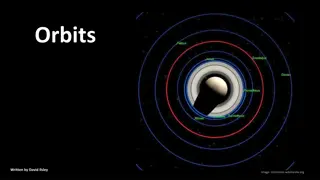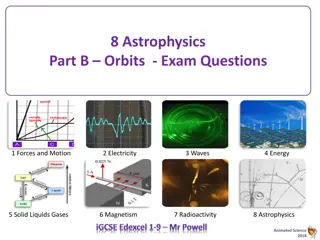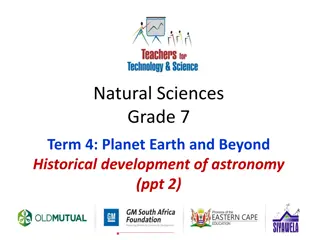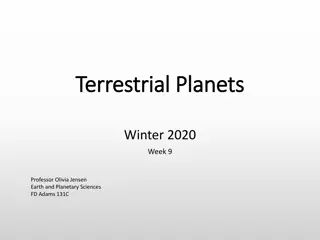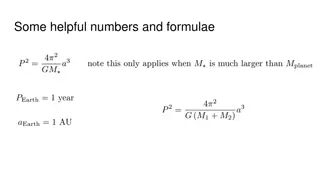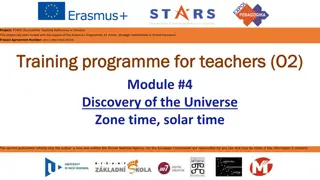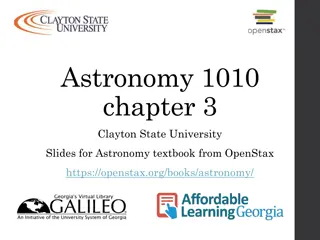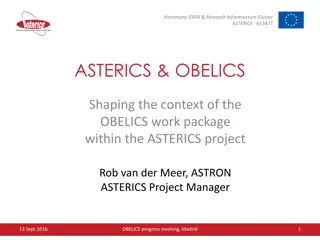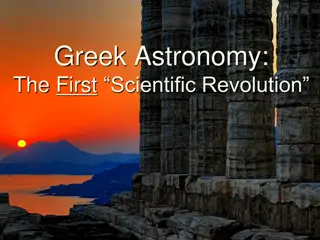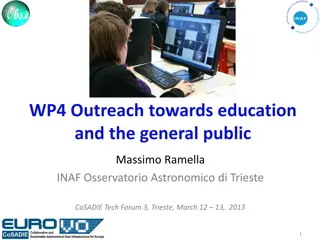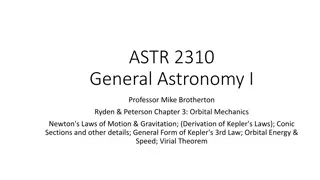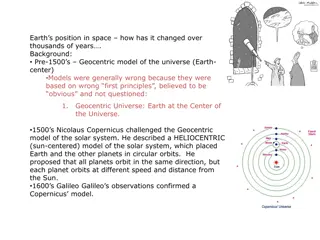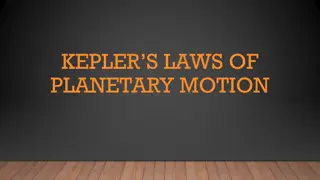Understanding Orbits and Kepler's Laws in Astronomy
Orbits and Kepler's Laws play a crucial role in understanding the movement of planets, moons, comets, and binary stars in our universe. Kepler's laws describe the elliptical orbits of planets around the Sun, the equal area law, and the relationship between a planet's distance from the Sun and its orbital period. Additionally, the concept of the center of mass is explored in relation to the Earth and the Sun. Conservation of angular momentum is used to prove Kepler's second law.
Download Presentation

Please find below an Image/Link to download the presentation.
The content on the website is provided AS IS for your information and personal use only. It may not be sold, licensed, or shared on other websites without obtaining consent from the author. Download presentation by click this link. If you encounter any issues during the download, it is possible that the publisher has removed the file from their server.
E N D
Presentation Transcript
Orbits and Keplers Laws Orbits and Kepler s Laws Kepler's laws: apply to planets around the Sun, moons around planets, comets, binary stars The planets move in elliptical orbits with the Sun at one focus: ??????????? ? : ?2= ?21 ?2 a is the semi-major axis b is the semi-minor axis
Orbits and Keplers Laws Orbits and Kepler s Laws 2. A line from the Sun to a planet sweeps out equal areas in equal times.
Orbits and Keplers Laws Orbits and Kepler s Laws 3. More distant planets orbit the Sun at slower average speeds, obeying a precise mathematical relationship. ? ? ???????? ???:?2= ?3 p is the planet s orbital period in years a is its average distance from the sun in Astronomical Units (AU)
Center of Mass Center of Mass The Earth and the Sun both orbit around their common center of mass. Putting the center of mass at the origin: ?? = ??; ?? ?+? Reduced mass ? =
Center of Mass Center of Mass So a more correct statement of Kepler s first law is: Each planet moves on an elliptical orbit with the center of mass at one focus. Question: The Sun has a mass of 2 1030 kg and the Earth has a mass of 6 1024 kg. 1 AU = 1.5 1011 m; The Sun s radius is 7 108 m Is the Sun-Earth s center of mass inside the Sun or outside?
Question: Question: Prove Kepler s second law, using conservation of angular momentum. (Use a circular orbit for simplicity) Hint: draw a diagram Hint: What area is swept out in time dt? Hint: Angular momentum ? = ? ?
In time dt, a planet moves an angle d along its orbit. Area of wedge is 1 2? ??? Distance moved = ???? = ??? 1 2? ???? So area =
Angular momentum: ? = ? ? ? ? = ???? Conservation of angular momentum at any point: ?1?1??1=?2?2??2 The planet s mass is unchanged, so: ?1??1= ?2?2
In time t: ? 1 ???? = 0 2????? Since ???doesn t change along the orbit, neither does the area. So Kepler s second law is simply a statement that angular momentum is conserved in the Solar System
Energy of Orbits Energy of Orbits Question: What are the two major contributions to the Earth s orbital energy?
Energy of Orbits Energy of Orbits Question: What are the two major contributions to the Earth s orbital energy? Answer: Kinetic and potential energy
Kinetic energy: ? =1 2??2 Gravitational Potential Energy: Since the gravitational force is a central force, energy is conserved and we can define potential energy. Derive formula for gravitational p.e: What is the work involved in pushing a planet away from the Sun? Using vector notation: ?? ? ? ? ? = ??
Using the gravitational force law and the fact that ? and ? are in the same direction: ????? ?2 ? = ?? ?? 1 ?? 1 ?? Integrating: ?? ??= ??? Pushing all the way to and defining ? = 0 ? = ??? ?
Looking at an asteroid in orbit around the Sun: Total energy of the system: ????.=1 2????? +1 ??? ?1+ ?2 2 2 2?????????? Define ?1+ ?2= ? ?????????= ?
Question: Question: We can ignore the term for the Sun s K.E. here. Why? Answer: ???????? =2?? ? P is the period (same for both)
2 ?? ??2 ?.?. ??? ?.?. ????????= So ? ?=?1 ?2 &?1 =? ? ( ?????? ?? ????) ?2 ? ?2 ?.?. ????????=? ?.?. ?2=? ? 1 Therefore So ????.=1 2??2 ??? ?
For a circular orbit: ? =2?? ? Kepler s third law in full form: ?2=4?2?3 , ? ? ??? ?? We can use this formula to estimate the mass of an object once we have something orbiting it
So ?2=4?2?2 =?? ?2 ? And ??????? ?????? =1 2??2=??? 2? (Same formula applies for ellipse, semi-major axis ? ?)
We can now simplify the formula for the total energy: ????.=1 2??2 ??? ? ????.=??? ??? 2? ? ????.= ??? 2? ????.< 0 ????? Formula holds for any bound orbit, using a (semi-major axis) for r. ????. Depends only on a, not eccentricity.
Three orbits, with the same semi-major axis but different eccentricities, have the same amount of orbital energy.
Closed orbits are in the shape of ellipses; as the energy increases, the orbit stretches out towards infinity until the orbit is a parabola and the body escapes.
For all bound orbits: 2??2 ??? ? Where r is the present radius, And a is the semi-major axis of the ellipse. 1 = ??? 2? Mass m cancels: orbit is the same for Jupiter or a matchbox, it depends on M (Sun s mass) and a. Total orbital energy doesn t change but K and U trade off. General formula for circular velocity: ?? ? ? =
You can use these formulae to work out speed and period of the Hubble Space Telescope, in its low-Earth orbit (600 km from the surface). ?????? ? ?????.= 6.67 10 11 6 1024 6378 + 600 103 = =7.6 km/s ? =2?? = 96 ???. ??
Escape Velocity: Escape Velocity: Take a satellite in orbit about the earth. If it burns fuel and increases total energy, eventually total energy will be zero and it will no longer be bound to the earth. ?.?.+?.?.= 0 2??2 ??? ?2=2?? 1 = 0 ? ? 2?? ? ?? ????.=
At the surface of Earth: ??= 11 ??/? Escape velocity from the solar system at 1AU: 2?? 1?? = 4.2 106?? = 4.2 104? ?= 42?? ? ? Question: What is the escape velocity from the solar system at the surface of the Sun ? For comparison, the Sun s orbital motion about the center of the Galaxy is~ 220 km/s.
Synchronous Satellites: Synchronous Satellites: Escape velocity is 2 circular velocity at the same r. ?? ? ? ????????: ??= Synchronous satellite: Takes 1 day to complete ITS orbit, going in same direction as Earth s rotation, so it appears fixed above one point.
Distance from Earth? 4?2?3 ?????? Kepler s third law: ?2= Period = 1 day = 24 3600s Solve for a: ?3=?2 ? ????? 24 36002 6 .7 10 8 6 1027 4?2 = 4?2 ? = 4.2 109 ?? ?? 42,000 ?? Earth s radius is 6378 km, so this is about 35,600 km above the surface. Quite different from low-Earth orbit!
Keplers second law revisited: Working in the center of mass frame Now use ?1,?2, ?1, ?2, ?1, ?2 ?1?2 ?1+?2 Reduced mass? =
Total orbital angular momentum of the system: ? = ?1 ?1 ?1+ ?2 ?2 ?2 This reduces to: ? = ? ? ? In general, the two-body problem may be treated as a one-body problem with the reduced mass mu moving about total mass M located at radius r



